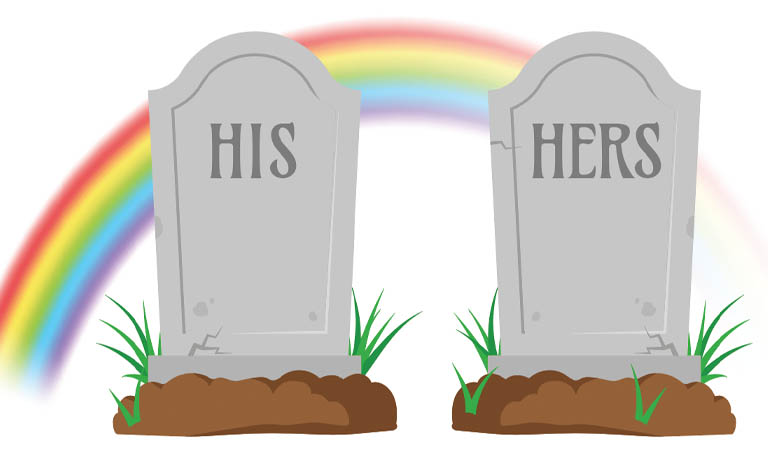A close friend’s recent phone call sounded so chipper, I figured she discovered a new place to live.
Turns out her ecstasy came from finding the perfect place for her husband and herself to be buried. (They’re both very much alive, albeit in their 80s.)
The lilt in her voice had a giddiness about it. Somehow, as the two of them found their way through the many options, this tough undertaking shaped into a joyous glimpse of their hereafter.
They purchased their plots and gravestones at the same time because they wanted to be sure of the location as well as the way the headstones were crafted. Headstones bought at different times might mean they wouldn’t match, she said.
They also hoped to be buried near as many family members as possible, which meant one sad compromise. They’d be buried near a freeway—an artistic sacrifice they were willing to make.
“Uh, you won’t be able to hear the traffic noise,” I said.
“Those who visit us might, though,” she replied.
They decided they wanted to be buried in biodegradable baskets, but a body in a basket can only be unrefrigerated for six hours. That means caskets for their funerals, then transferring their bodies to the baskets for burial. And baskets? Unlike caskets, much deeper holes are required to protect baskets from animal invasions.
The palpable relief in her voice—to have all this plotted out, pun intended—was ethereal, but she shared a warning. Some men, she said, are very sensitive when it comes to discussions about death.
“I really am not afraid of death. My fear is living too long!” she said with a laugh, then added, “What are you two going to do, anyway?”
“We want to be cremated,” I told her.
“Cremated? Wonderful! Then your ashes could be buried in biodegradable boxes to rest on our baskets or what’s left of them. We’ll have room for three boxes of ashes on each basket. How cool that would be!”
That got me thinking. Although she and her husband are great friends, do we want our ashes down under on their baskets—or on anybody else’s, for that matter? Our parents, perhaps? Not in the cards for me. My father was cremated and his ashes were scattered from a plane over Lake Michigan. My mother is buried on a lovely plot that unfortunately is under the flight path to Chicago’s O’Hare International Airport. I’ve only a few cousins and high school cronies left in the Chicago area. Most deceased members of Howie’s family are buried in Lewis County, Washington.
My friend’s delight to have so much planned ahead of time was contagious. How many urns or biodegradable boxes would we want? Before selecting the perfect urns, boxes, or settings for our ashes, I found online Mary Anne Vance, a savvy Seattle elder law attorney, who shares other options for these difficult decisions.
Some, for example, might want to consider organ donation or a Willed Body Program at a university to help educate medical professionals of the future.
Deciding about someone’s remains has political and environmental implications as well. Skipping the flame is a big part of that. Alkaline hydrolysis, sometimes called water cremation, has less environmental impact because it takes less energy and eliminates direct emissions of greenhouse gases or metals, Vance notes. She also mentions green burials that return bodies to natural burial grounds, such as one owned by White Eagle Memorial Preserve, a nonprofit in Goldendale, Wash.
Climate change has an urgency that continues to create new alternatives. A Seattle firm called Recompose is a licensed funeral home that does human composting to transform bodies into nutrient-rich soil to give to loved ones. Recompose even schedules both small, in-person and virtual guided tours, according to its website.
As a newspaper reporter in the 1970s, I wrote about a suggestion to purchase your own coffin—one with a flat top—when you’re young and healthy. Give it life as a living-room coffee table to help warm up to the notion of your own passing. Funeral directors I interviewed said there weren’t many requests for coffins without funerals, but they liked the idea.
Who would’ve fathomed that coffins might soon become relics of yesteryear?
Annie Culver developed a knack for unearthing oddball characters and improbable events as a staff writer for various newspapers. In the early 90s, she went to work for websites where she wrote sassy essays aimed at women. In recent years, she morphed into a writer for several universities in the Northwest. She retired in 2016, yet still enjoys freelancing.
Read more of Annie Culver’s take on life’s absurdities here.


